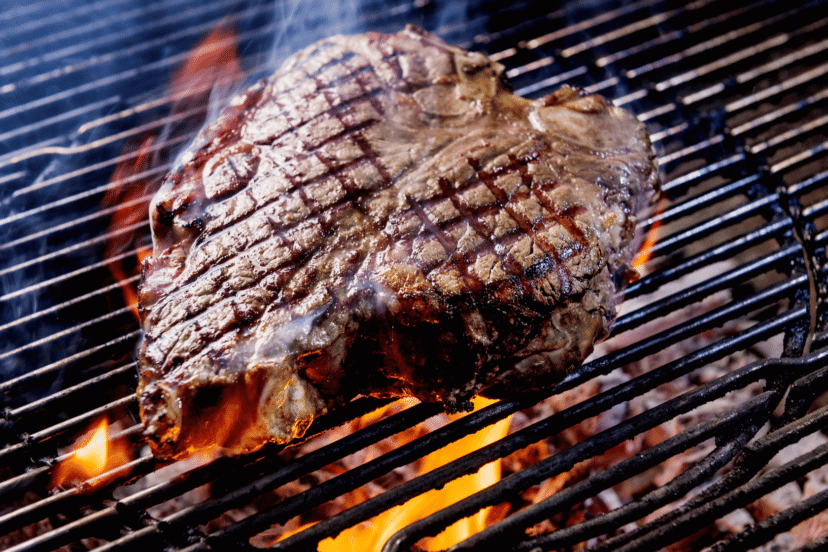How to Cook Bison Steak
Are you looking to level up your steak game by adding a delicious and nutritious twist? Look no further, as bison steak is the perfect choice for both flavor and health benefits! Bison meat is leaner than beef, high in iron, and sure to impress any dinner guest. Let’s find out how to cook bison steak!
In this blog post, we’ll walk you through everything you need to know about how to cook bison steak like a pro – from selecting the right cut of meat to mastering various cooking techniques.
Table of Contents
- 1 Understanding Bison Steak
- 2 Cooking Techniques For Bison Steak
- 3 Cooking Tips For Bison Steak
- 4 Seasoning And Serving Options For Bison Steak
- 5 Frequently Asked Questions
- 5.1 How Long Should I Cook Bison Steak?
- 5.2 What Is The Ideal Temperature For Bison Steak?
- 5.3 How Do I Know When The Steak Is Done?
- 5.4 How do I prepare a bison steak before cooking it?
- 5.5 What is the best way to cook a bison steak?
- 5.6 How can I ensure my bison steak is cooked correctly?
- 5.7 Can I marinate my bison steak before cooking it?
- 6 Conclusion
Key Takeaways
- Bison steak is a lean and flavorful alternative to beef, with numerous health benefits and a unique taste that requires proper preparation and cooking techniques.
- Choosing the right cut of bison steak is crucial to getting the most flavor out of your meal. There are several options, each with their unique characteristics.
- To cook a delicious bison steak, there are various cooking techniques to choose from such as grilling, pan-searing, and oven-roasting. It’s important not to overcook the meat to prevent dryness.
- Seasoning options for bison steak can range from simple salt and pepper blends to garlic and herb rubs or citrus-based marinades. Popular side dishes include roasted vegetables, creamy mashed potatoes or tangy chimichurri sauce.
Understanding Bison Steak
Bison steak is a lean and flavorful alternative to traditional beef, with numerous health benefits and a unique taste that requires proper preparation and cooking techniques.
Benefits Of Bison Meat
Bison meat has gained popularity in recent years as a delicious and nutritious alternative to beef. One of the primary benefits of choosing bison over traditional meats is its lower fat content.
In fact, bison meat typically contains only 2-3 grams of fat per serving, making it an ideal option for those seeking a lean source of protein without sacrificing taste.
Aside from its low-fat and calorie content, bison meat also boasts higher levels of essential nutrients needed for optimal health. Packed with iron, zinc, and B vitamins such as niacin and B12, consuming bison can help boost energy levels while supporting immune function and red blood cell production.
Furthermore, the rich flavor profile often attributed to bison’s high iron content sets it apart from other meats on the market.
Choosing The Right Cut
Before knowing how to cook bison steak, choosing the right cut of bison steak is crucial to getting the most flavor out of your meal. There are several options, including ribeye, tenderloin, sirloin, flank and brisket, each with their unique characteristics.
The ribeye cut offers excellent marbling and a juicy flavor that is perfect for grilling or broiling. The tenderloin, on the other hand, is much leaner but still delivers tender meat that can be roasted or grilled.
Sirloin and flank cuts are slightly tougher but work well when marinated before cooking. Brisket cuts are best slow-cooked in the oven or sous-vide until they reach a fall-apart texture.
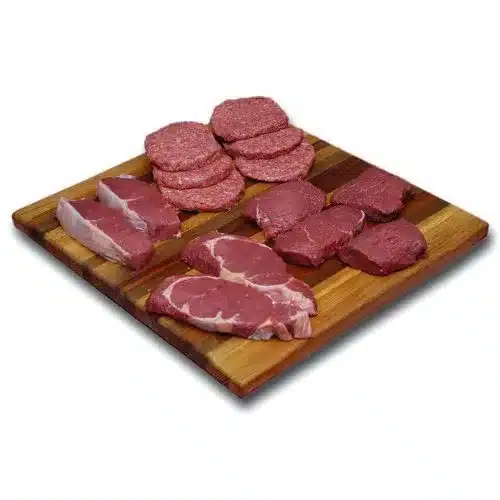
If you want to try a few different cuts and even a bison burger this combo pack might do the trick for you!
Bison Burgers & Steak Combo Pack: 14 Piece (Total 6.25 lbs.)
This pack includes: 2 Ribeye Steaks (10 oz.), 2 New York Strip Steak (8 oz.), 4 Sirloin Steak (8 oz.), 6 Bison Burgers Patties (5.3 oz) – Grass Fed Bison – TenderBison
Preparing The Steak
Before cooking your bison steak, it’s essential to prepare it properly. First, remove the steak from the fridge at least 30 minutes before cooking to allow it to come to room temperature.
Next, pat the meat dry with a paper towel and season both sides liberally with salt and pepper or your preferred seasoning blend.
When choosing the right cut of bison steak, look for options that are well-marbled and have good fat content as this will keep them juicy during cooking. Popular cuts include ribeye, striploin, tenderloin fillet and top sirloin.
Cooking Techniques For Bison Steak
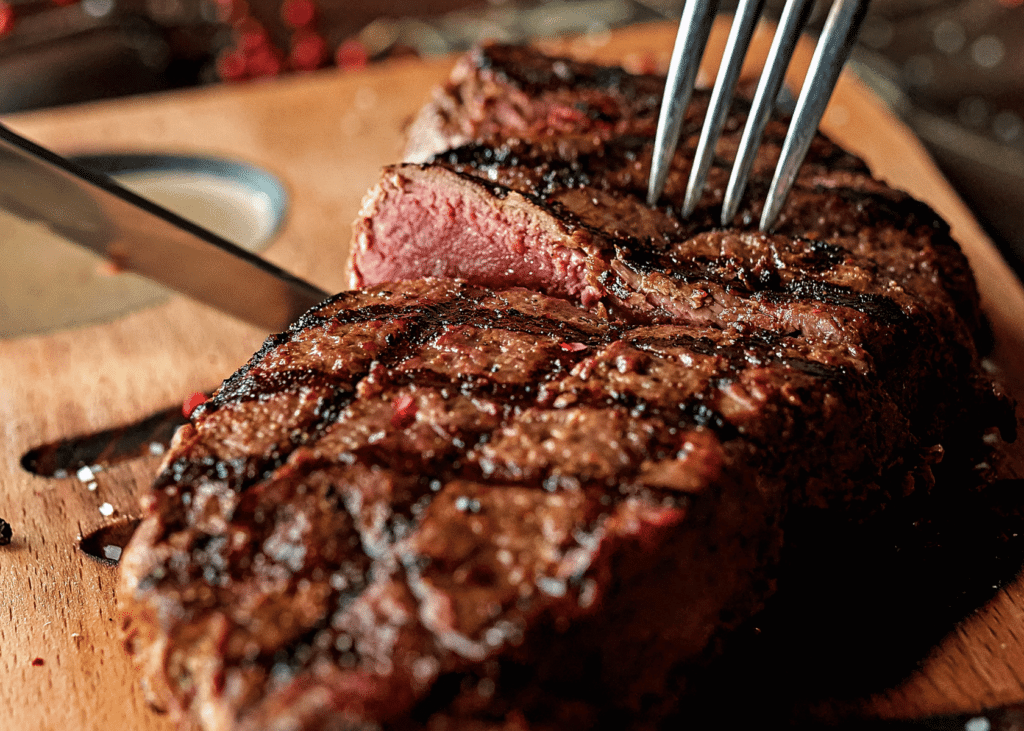
To cook a delicious bison steak, there are various cooking techniques to choose from such as grilling, pan-searing, and oven-roasting.
Grilling
Grilling bison steak is a popular cooking technique that can impart a delicious smoky flavor to the meat. To get started, preheat your grill to medium-high heat, around 450-500 degrees Fahrenheit.
Remove the bison steak from the fridge and let it come to room temperature for at least 30 minutes before grilling.
Place the seasoned bison steak on the grill grates and close the lid. Grill for about 3-4 minutes per side for a rare or medium-rare doneness, flipping only once. For bigger cuts like ribeye, sear both sides first over high heat before moving it over indirect heat for an additional 8-10 minutes until desired doneness is reached according to recommended internal temperature of 145°F (medium rare) or up to a maximum of 160°F (medium).
Keywords: Grilling bison steak, Smoky flavor, Preheat your grill, Medium-high heat , Rare or medium-rare doneness , Recommended internal temperature , Resting period
Pan-searing
Pan-searing is a great option for cooking bison steak if you don’t have access to an outdoor grill. To start, heat up a cast-iron skillet on medium-high heat and add a tablespoon of oil to the pan.
Once the oil is hot, place your seasoned bison steak in the pan and let it sear for about two minutes per side or until browned.
It’s important to note that when pan-searing bison steak, you should avoid flipping it too often as this can prevent it from developing a nice crust. If you’re unsure if the meat is cooked through, use a meat thermometer to check its internal temperature; remember that bison steaks are best served rare or medium-rare with a slightly pink center.
Oven-roasting
If you prefer a more hands-off approach to cooking bison steak, then oven-roasting is the way to go. First, preheat your oven to around 275°F. Next, season your bison steak with salt and pepper or any other desired herbs or spices.
It’s important not to overcook the bison steak in the oven as it can lead to dryness. Aim for about 15 minutes per pound when roasting larger cuts like prime rib or round.
Don’t forget to let the meat rest when learning how to cook bison steak for a few minutes before slicing into it so that all those delicious juices stay inside.
Cooking Tips For Bison Steak
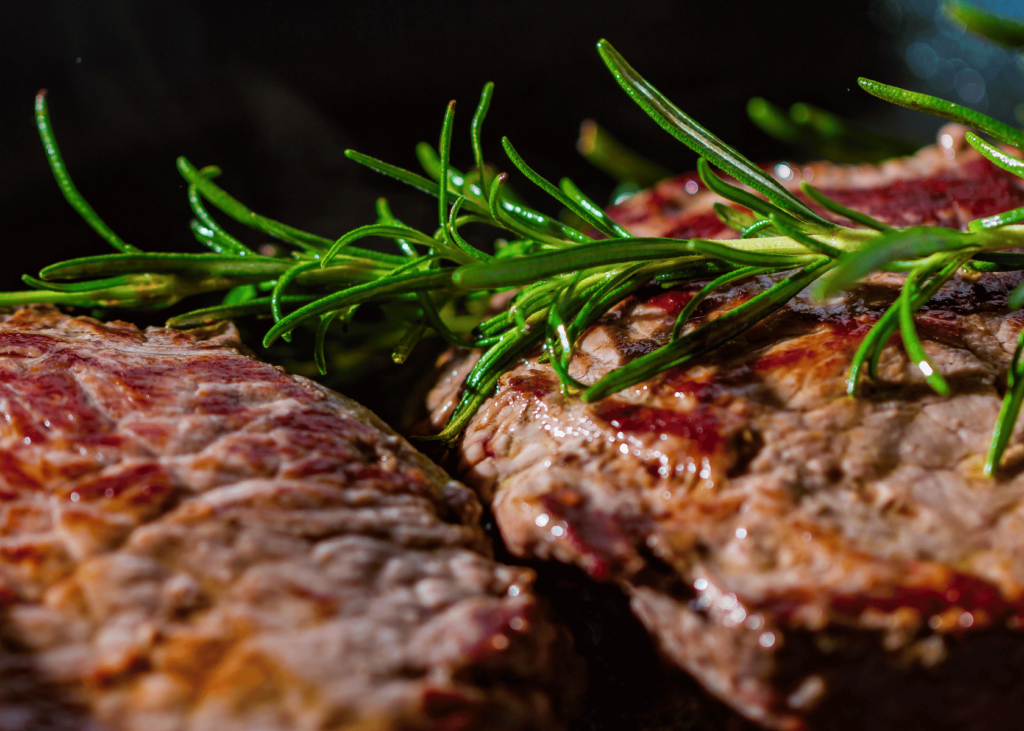
Cook bison steak to medium-rare or rare for the best flavor.
Cook To Medium-rare Or Rare For The Best Flavor
For the best flavor, it’s recommended to cook bison steak to medium-rare or rare. This ensures that the meat stays tender and juicy, with a slightly pink center. Overcooking can lead to dryness and toughness in the meat.
It’s important to note that bison meat cooks faster than beef due to its lower fat content. Therefore, monitoring the temperature with a meat thermometer is crucial when cooking bison steak.
Once it reaches an internal temperature of 145°F (medium-rare) or 160°F (medium), take it off the heat and let it rest for a few minutes before slicing into it.
Let The Meat Rest For A Few Minutes Before Slicing
It is essential to let your bison steak rest before slicing into it. This step allows the juices to redistribute evenly throughout the meat, resulting in a more flavorful and moist steak.
A good rule of thumb is to rest the steak for at least five minutes after cooking.
Additionally, letting your bison steak rest will make it easier to slice without losing its juiciness and flavor. Slicing too soon can cause all those juicy goodness you’ve worked hard for during cooking to spill out onto the plate instead of on your taste buds.
Avoid Overcooking To Prevent Dryness
Overcooking bison steak can lead to dry, tough meat. To prevent this, it’s important to cook the steak only until it reaches the desired internal temperature. Bison steaks should be cooked to medium-rare or rare for the best flavor and texture.
Another trick is to avoid piercing or cutting into the steak while cooking, as this can cause juices to escape and result in dryness. Instead, use tongs or a spatula when flipping the steak on the grill or pan-searing it on high heat.
Seasoning And Serving Options For Bison Steak
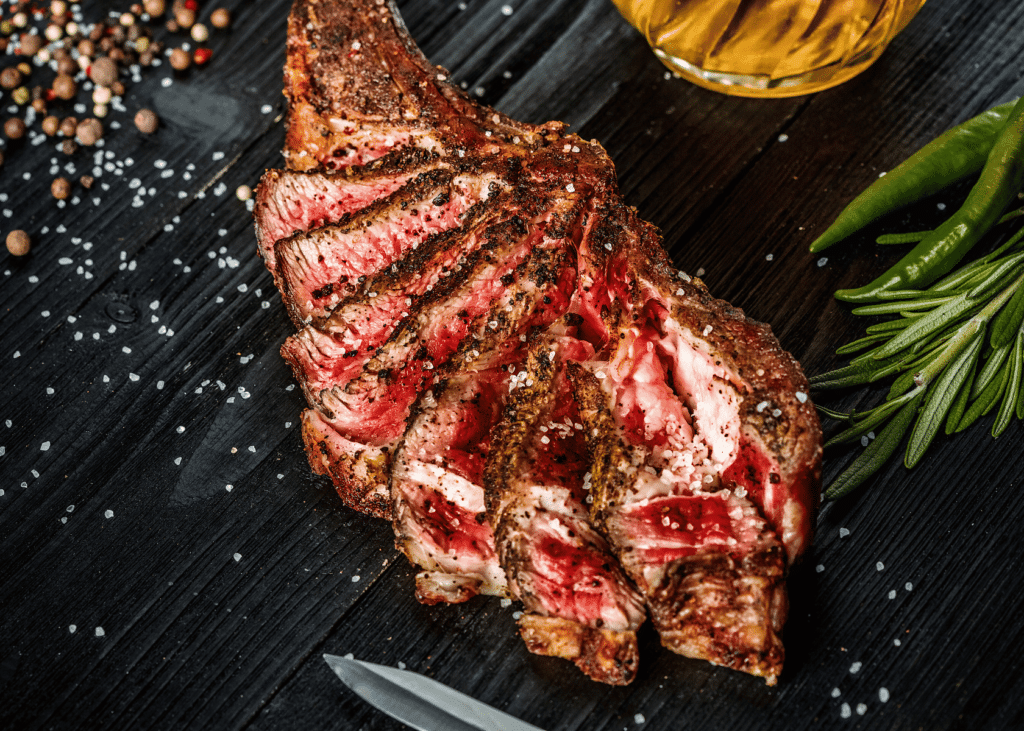
When talking about how to cook bison steak, seasoning is important!
For seasoning, you can opt for a simple salt and pepper blend or go for something more complex like garlic and herb rubs, citrus-based marinades, or even sweet ginger-soy glazes.
As for sides and sauces, some classic pairings include roasted vegetables, creamy mashed potatoes, smoky barbecue sauce or tangy chimichurri.
Simple Salt And Pepper
One of the simplest ways to season bison steak is with just salt and pepper. This classic combination allows the natural flavor of the meat to shine through without overpowering it.
To use this seasoning method, generously sprinkle both sides of the steak with coarse sea salt and freshly ground black pepper before cooking.
It’s worth noting that bison meat has a flavor similar to beef but slightly sweeter, nuttier, and earthier due to its leaner nature. As such, simple seasoning like salt and pepper can be enough or enhance these unique attributes in every bite.
Garlic And Herbs
Adding garlic and herbs to bison steak is a great way to enhance its natural flavor. One popular herb for seasoning bison meat is rosemary, which pairs well with the earthy taste of the lean meat.
Simply chop up fresh rosemary and mix it in with minced garlic, black pepper, and olive oil for a delicious marinade that will make your bison steak burst with flavor. Another tasty option is to use thyme and sage as part of your seasoning blend – these herbs bring out the richness of the meat and add complexity to every bite.
Citrus-based Marinades
Citrus-based marinades are a great way to add some tangy flavor to your bison steak, and they pair particularly well with the lean meat. To make a simple citrus marinade, combine lemon or lime juice with olive oil and garlic.
Marinating the bison steak in this mixture overnight will help tenderize it and infuse it with delicious flavors. When you’re ready to cook, simply remove the steak from the marinade (discarding any excess liquid) and grill or pan-sear as directed in our cooking techniques section above.
Best Sides And Sauces
When it comes to sides and sauces for bison steak and how to cook bison steak, there are plenty of options that can elevate the flavor profile of your meal. If you’re going for a classic steakhouse vibe, consider pairing your bison steak with garlic mashed potatoes and roasted asparagus.
As for sauces, keep it simple with a drizzle of olive oil or melted butter over the steak. Alternatively, whip up a homemade chimichurri sauce made from fresh herbs like parsley and cilantro blended with garlic, red wine vinegar, and olive oil.
And don’t forget about wine pairings – a bold red like cabernet sauvignon or merlot can complement the rich flavors of bison meat perfectly.
Wine And Beer Pairings
A delicious bison steak deserves a perfect beverage pairing to complement its unique flavor. When it comes to wine, red wines like Cabernet Sauvignon or Syrah pair well with bison steak due to their bold flavors and tannins that cut through the meat’s richness.
If you prefer white wine, Chardonnay or Viognier can also work, especially if they have a buttery and oak-aged taste. On the other hand, for beer lovers, an IPA or Stout can balance the sweetness and bitterness of bison meat while bringing out its smoky notes.
Frequently Asked Questions
How long should I cook bison steak? How to cook bison steak? What is the ideal temperature for bison steak? How do I know when the steak is done? These are common questions about cooking bison steak that will be answered in this section.
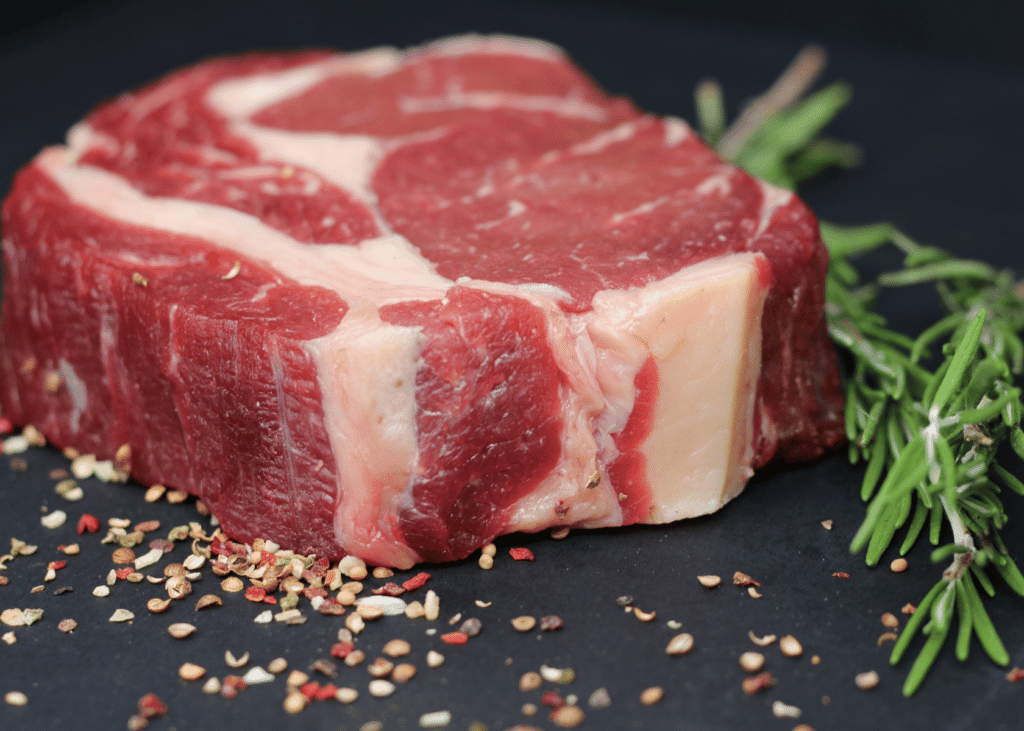
How Long Should I Cook Bison Steak?
When it comes to cooking bison steak, the ideal cooking time varies depending on the thickness of the cut and the preferred level of doneness. As a general rule, it’s recommended to sear or grill bison steaks for 3-5 minutes per side over high heat for a rare to medium-rare finish.
For medium doneness, increase the cooking time by 1-2 minutes per side. However, this is just an estimate, and using a meat thermometer is always recommended to ensure that your bison steak reaches the perfect internal temperature of 145°F (medium rare) or 160°F (medium).
What Is The Ideal Temperature For Bison Steak?
Bison steaks should be cooked to an internal temperature of 145°F for medium-rare or 160°F for medium. This ensures that the meat is cooked through while still retaining its tenderness and juiciness.
When cooking bison steak, it’s important to use a meat thermometer to ensure that it reaches the correct temperature before serving. Overcooking can result in dry and tough meat, so it’s important not to exceed these recommended temperatures.
How Do I Know When The Steak Is Done?
The key to perfectly cooking bison steak is getting the internal temperature just right. The best way to ensure your steak is done to your desired level of doneness is by using a meat thermometer.
For medium-rare bison steaks, the recommended internal temperature is 145°F, while medium should reach 160°F. You can also use the touch test method where pressing the center of the steak with your finger will indicate its level of doneness; a rare steak feels soft and squishy, while a well-done one feels firm and tough.
How do I prepare a bison steak before cooking it?
Before cooking your bison steak, make sure to let it come to room temperature for about 30 minutes. Season the steak with salt and pepper or any other desired spices and rub them into the meat thoroughly.
What is the best way to cook a bison steak?
Bison steaks are typically leaner than beef and require less cooking time. The recommended method would be grilling over high heat or searing in a cast-iron skillet on medium-high heat for around 3-4 minutes per side.
How can I ensure my bison steak is cooked correctly?
Using a meat thermometer helps you ensure that your bison steaks have reached their ideal internal temperature: rare at 120°F, medium-rare at 130°F, medium at 140°F, and well-done at 160°F.
Can I marinate my bison steak before cooking it?
Absolutely! A simple marinade consisting of olive oil, garlic, herbs like rosemary or thyme, soy sauce or Worcestershire sauce works wonders with Bison Steak as they help tenderize the lean meat while adding flavor.
Conclusion
Now that you have learned how to cook bison steak, it’s time to put your skills into practice. So, you can enjoy the delicious taste and health benefits of this lean meat. Remember to choose the right cut, cook it to medium-rare or rare for the best flavor, let it rest before slicing, and experiment with different seasoning and serving options.
Whether you grill it, sear it on a pan, or roast it in the oven – bison steak is a versatile dish that can be enjoyed in various ways.
*We may earn a commission for the purchases made using our links. Please see our disclosure to learn more.

